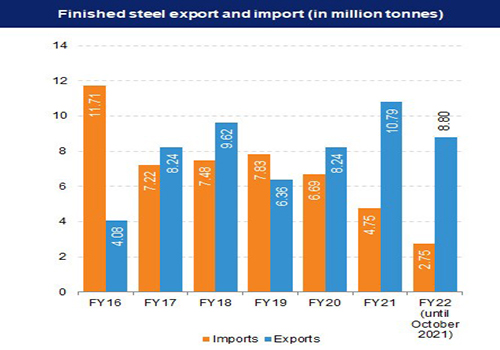Date: 24/04/2023
Relevance: GS-3: Infrastructure: Energy, Ports, Roads and environment
Key Phrases: green hydrogen, Commonwealth Industrial and Scientific Research Organization (CSIRO), Green Steel Initiative, huge cooking pots, automotive tyres, blast furnaces, electric arc furnace.
Context:
- Green steel production, which uses hydrogen as the reducing agent to produce steel without carbon emissions, is unlikely to happen anytime soon in India due to several technical and economic challenges.
Do you know?
- Steel is an alloy composed mainly of iron with varying amounts of carbon, depending on the grade and type of steel.
- Other elements such as manganese, chromium, nickel, and tungsten are also commonly added to improve its properties.
- Carbon is the main alloying element in steel and it plays a crucial role in determining its strength, hardness, and other mechanical properties.
- The amount of carbon present in steel can range from 0.03% to 2.0% by weight.
- Steels with higher carbon content are generally stronger and harder, but also more brittle.
What is Green Steel?
- ‘Green steel’, or the steel produced through processes that do not emit carbon dioxide, essentially means using hydrogen as the ‘reducing agent’ (remover of oxygen) in steel production.
- In other words, iron ore is basically iron oxide and hydrogen is used to pull oxygen away from iron oxide, leaving pure iron behind—to which a little carbon is added to make steel.
- Right now, carbon, in the form of coke, has been used for pulling away oxygen; when carbon joins hands with oxygen it becomes carbon dioxide, which is today mankind’s greatest enemy.
- Hydrogen can do the job of coke just as well.
- Much of Indian iron ore is unsuitable for making green steel.
- According to Australia’s Commonwealth Industrial and Scientific Research Organization (CSIRO),66 per cent of India’s (and Australia’s) iron ore is not suitable for being made into green steel.
- This is because Indian iron ore is low-grade. Low-grade iron ore can only be made into steel in blast furnaces—huge cooking pots in which iron ore is melted and made to combine with coke, before being poured into moulds for making steel slabs.
- For technical reasons, green steel making requires the ‘electric arc furnace’ route; EAFs need high-grade ores, in which iron content is over 60 per cent.
What are other challenges associated with Green Steel Production in India?
- Hydrogen releases a lot less heat:
- Blast furnaces need to operate at high temperatures, around 1,000-1,200 degrees C, and combustion of hydrogen releases a lot less heat compared to the combustion of coke.
- Therefore, hydrogen must be pre-heated to high temperatures to provide sufficient heat for the blast furnaces.
- Pre-heating hydrogen means using more energy, which must come from renewable sources so that the steel qualifies for the ‘green’ label.
- Embrittlement of iron:
- The use of hydrogen results in ‘embrittlement’ of iron, leading to cracks and fractures in the metal. To avoid this, special alloys are needed to resist hydrogen embrittlement.
- Therefore, producing green steel in blast furnaces by injecting hydrogen as a replacement of coke is technically challenging and economically infeasible.
- The CSIRO concurred that high-grade iron ore or steel scrap is needed for making steel through the EAF route—neither of which is available in India in the required quantities.
- India has invested tens of billions of dollars into creating blast furnace-based steel production, which is not suitable for producing green steel.
- Blast furnaces are big emitters of carbon dioxide.
- A blast furnace capable of producing 2 million tons of steel annually will emit at least 2.5 million tons of CO2 a year.
- There is currently no commercially available low-carbon steel-making route for a majority of Indian and Australian ores.
Note:
- In 2022, India produced 124.5 million tonnes of steel. The country produced 25.1 million tonnes of iron ore between April and December 2022.
Alternative Technologies
- One alternative is to replace a portion of the coke used in blast furnaces with used automotive tires, which contain around 7% hydrogen.
- The Indian Institute of Science is also exploring the use of biochar to replace some of the coke in blast furnaces.
- Tata Steel has developed a new technology called HIsarna, which can reduce CO2 emissions by 80% compared to blast furnace routes.
- In HIsarna, the ore is liquefied in a high-temperature cyclone at the top, and the molten ore drips to the bottom of the reactor where powder coal is injected.
- HIsarna requires fewer pre-processing steps and less stringent conditions on the quality of the raw materials used.
- The technology produces highly concentrated carbon dioxide, making it ideal for carbon capture and either storage or use without a costly gas separation stage.
India-Australia Green Steel Initiative
- In June 2021, the Indian and Australian governments formed an India-Australia Green Steel Partnership to work on a range of research, technology and commercialisation projects over a three-and-a-half year period to accelerate the steel making value chain in both the countries.
- CSIRO of Australia is working with a few Indian labs.
- For instance, it is working with the Institute of Minerals and Materials Technology (IMMT), Bhubhaneshwar, which is working on a plasma technology for “very rapid melting of iron oxide using hydrogen”.
Conclusion:
- The production of green steel in India is a complex task that requires significant investment in infrastructure, technology, and raw materials.
- The government needs to address these challenges and provide a conducive environment for the growth of the green steel industry.
Source: The Hindu BL
Mains Question:
Q. Discuss the concept of green steel and explain the challenges associated with its production in India. (250 Words).
























